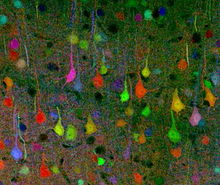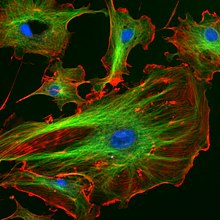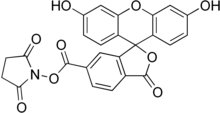Fluorescent marking
The fluorescent label is a method of biochemistry for labeling of biomolecules with fluorophores .
principle

Biomolecules are sometimes provided with fluorescent molecules to facilitate tracking. By coupling fluorophores to proteins or carbohydrates on the cell surface , cells can also be marked directly or indirectly detected with fluorescent immunoconjugates , e.g. B. by flow cytometry , fluorescence microscopy or fluorescence tomography .
In the case of fluorescent labeling, the molecule to be detected can be provided directly with a fluorophore or indirectly detected by means of selectively binding fluorescent molecules. Methods for fluorescent labeling are:
- Direct molecular detection
- chemical coupling (only in vitro )
- bioorthogonal marking
- fluorescent reporter molecules
- fluorescent protein tags , protein tags with fluorophore coupling ( flash tag ) or RNA tags
- Indirect molecular detection
Proteins

In the case of proteins , the green fluorescent protein (GFP), among other things, is used in vivo as a recombinant fusion protein or as a reporter gene . Inteins can be used for the C-terminal labeling of proteins. The flash tag can also be used as a fluorescent protein tag . With redox- dependent fluorescent proteins such as roGFP , rxYFP and HyPer , the fluorescence can be changed depending on oxygen. With voltage-dependent proteins such as VSFP , the fluorescence can be changed by applying an electrical voltage.
Proteins can also be labeled partially synthetically (bioorthogonal) by incorporating reactive amino acid derivatives in vivo , which are then coupled in vitro with a fluorophore. Furthermore, proteins are provided with different fluorophores with different chemical coupling reactions in vitro . For example, nucleophilic groups ( amino groups occur most frequently in proteins) can be produced by reactions with isothiocyanates (e.g. FITC , TRITC ), succinimidyl esters (e.g. CFSE ) with different fluorescent dyes such as. B. fluorescein , rhodamine and their derivatives are labeled. 1-Fluoro-2,4-dinitrobenzene and dansyl chloride react with amino groups. Cysteines can be labeled with IAEDANS or Ellman's reagent . Proteins can also be detected indirectly by immunolabeling with fluorescent immunoconjugates, e.g. B. in fluorescence microscopy, Western blot and immunoassay . In the course of a peptide synthesis , peptides can be labeled using fluorescent amino acid derivatives. Using Förster resonance energy transfer (FRET), bioluminescence resonance energy transfer (BRET), fluorescence correlation spectroscopy (FCS) or bimolecular fluorescence complementation (BiFC), the proximity of two proteins can be detected with fluorophores.
Nucleic acids
DNA can be labeled bioorthogonally. For this purpose, DNA can be labeled in vivo or in vitro with nucleoside analogs which, for. B. can then be coupled with a fluorophore by Staudinger reaction . DNA can be chemically provided with fluorophores. Oligonucleotides can be labeled by a phosphoramidite synthesis with fluorophores, the z. B. in QPCR , DNA sequencing and in situ hybridization can be used. In addition, DNA can be generated enzymatically in the course of a polymerase chain reaction with fluorescent nucleotides or labeled with a ligase or a terminal deoxynucleotidyl transferase. DNA can be detected indirectly by biotinylation and fluorescent avidin . Fluorescein, fluorescent lanthanoids , gold nanoparticles, carbon nanotubes or quantum dots are used as fluorophores for couplings .
literature
- F. Borek: The fluorescent antibody method in medical and biological research. In: Bulletin of the World Health Organization. Volume 24, Number 2, 1961, pp. 249-256, PMID 20604086 , PMC 2555496 (free full text).
Individual evidence
- ^ SJ Smith: Circuit reconstruction tools today. In: Current opinion in neurobiology. Volume 17, number 5, October 2007, pp. 601-608, doi : 10.1016 / j.conb.2007.11.004 . PMID 18082394 . PMC 2693015 (free full text).
- ^ CP Toseland: Fluorescent labeling and modification of proteins. In: Journal of chemical biology. Volume 6, Number 3, April 2013, pp. 85-95, doi : 10.1007 / s12154-013-0094-5 . PMID 24432126 . PMC 3691395 (free full text).
- ↑ S. Lindström: Flow cytometry and microscopy as Means of studying single cells: a short introductional overview. In: Methods in molecular biology (Clifton, NJ). Volume 853, 2012, pp. 13-15, doi : 10.1007 / 978-1-61779-567-1_2 . PMID 22323136 .
- ↑ D. Jung, K. Min, J. Jung, W. Jang, Y. Kwon: Chemical biology-based approaches on fluorescent labeling of proteins in live cells. In: Molecular bioSystems. Volume 9, Number 5, May 2013, pp. 862-872, doi : 10.1039 / c2mb25422k . PMID 23318293 .
- ^ CC Wang, TS Seo, Z. Li, H. Ruparel, J. Ju: Site-specific fluorescent labeling of DNA using Staudinger ligation. In: Bioconjugate Chemistry . Volume 14, Number 3, 2003 May-Jun, pp. 697-701, doi : 10.1021 / bc0256392 . PMID 12757398 .
- ↑ a b L. J. Kricka, P. Fortina: Analytical ancestry: "firsts" in fluorescent labeling of nucleosides, nucleotides, and nucleic acids. In: Clinical chemistry. Volume 55, number 4, April 2009, pp. 670-683, doi : 10.1373 / clinchem.2008.116152 . PMID 19233914 .
- ↑ JM Prober, GL Trainor, RJ Dam, FW Hobbs, CW Robertson, RJ Zagursky, AJ Cocuzza, MA Jensen, K. Baumeister: A system for rapid DNA sequencing with fluorescent chain-terminating dideoxynucleotides. In: Science (1987), vol. 238 (4825), pp. 336-41. PMID 2443975 .
- ↑ RW Richardson, RI Gumport: biotin and fluorescent labeling of RNA using T4 RNA ligase. In: Nucleic acids research. Volume 11, Number 18, September 1983, pp. 6167-6184, PMID 6194506 . PMC 326365 (free full text).
- ↑ H. Eshaghpour, D. Söll, DM Crothers: Specific chemical labeling of DNA fragments. In: Nucleic acids research. Volume 7, Number 6, November 1979, pp. 1485-1495, PMID 228251 . PMC 342322 (free full text).
- ↑ J. Nurmi, T. Wikman, M. Karp, T. Lövgren: high-performance real-time quantitative RT-PCR using lanthanide probes and a dual-temperature hybridization assay. In: Analytical chemistry. Volume 74, Number 14, July 2002, pp. 3525-3532, PMID 12139064 .
- ↑ A. Lehmusvuori, AH Tapio, P. Mäki-Teeri, K. Rantakokko-Jalava, Q. Wang, H. Takalo, T. Soukka: Homogeneous duplex polymerase chain reaction assay using switchable lanthanide fluorescence probes. In: Analytical biochemistry. Volume 436, number 1, May 2013, pp. 16-21, doi : 10.1016 / j . from 2013.01.007 . PMID 23353013 .


